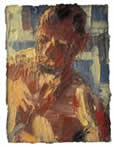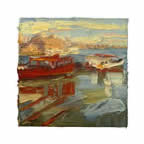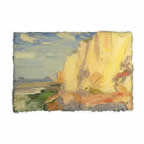 |
 |
 |
 |
So far as is known, the art of landscape painting scarcely exists before the exquisite expressions of space and distance by anonymous Chinese artists working decoratively on silk in about 300 A.D. The modern western notion of landscape as an art form in its own right had a sort of pre-natal existence in the backgrounds of Italian Renaissance portraits. Since the seventeenth century landscape painting has survived some difficult periods. Napoleon has been accused of almost extinguishing it in France by making Jacques-Louis David a virtual dictator in artistic matters, but it was rescued by the Romantic Movement and by the Barbizon School, the members of which, like George Rowlett today, opened themselves to the forces of nature by painting in the open air. With Turner and Constable, landscape became the only branch of painting in which the nineteenth century English School exerted some influence upon major French artists. In the middle of the twentieth century, when Abstract Expressionism was known as the International Style, and when many figurative painters from Picasso to Bacon virtually ignored landscape, it was almost as if the torch of painting in the open air had been passed to the swelling throng of Sunday painters. In 2003, serious painters of all sorts find themselves contending for exhibition space and critical attention with the somewhat tenacious fashion for conceptual art, an art which often requires little more from the artist than his thoughts.
George Rowlett has been known to turn both flowers and people into paint - in a manner of speaking. In his hands the sheer volume of thickly applied paint seems to marry subject and medium inextricably. His self-portraits, including the recent 'Summer Self Portrait, Recuperation' 2002 combine an acceptable degree of legibility with an absence of confusing detail. The result generates a somewhat mysterious air, thereby cementing, perhaps, such historic links as may exist between art and magic. Above all, however, George Rowlett has created a great series of landscapes. He has carved out his own modest but distinct place in the evolution of landscape painting. Viewed from very close, the images in Rowlett¹s landscapes dissolve into swirling abstractions. His landscapes make their presence felt not only as lively, original and imaginative renderings of the busy Thames or the quiet cornfields, cliffs and churchyards of Kent, but also as weighty, tactile physical objects.
A blind person could easily be talked through a Rowlett landscape once the paint had dried. He or she could run a finger horizontally along the hull of the red boat in 'Red White and Blue, Cruisers at Cherry Garden Pier, Low Tide Bright Sunlight' 2002 counting the two or three broad and sweeping strokes of the palette knife with which it is depicted. As a contrast the same blind person could then feel the vertical strokes which render the bark and trunk of the ancient Walmer Yew. This subject was suggested by the poet and critic Andrew Lambirth, an authority on Rowlett¹s work, to accompany a poem. It was a project that yielded some five recent paintings. A blind person might also feel the smaller vertical strokes which, almost like little stalactites, depict a lower part of the ochre-coloured cliffs in 'Under Kingsdown Cliffs, Morning Sunlight' 2002. How very different such an approach to landscape this is from the smooth-surfaced window on the world that a Canaletto, for example, gives us from the eighteenth century. A Rowlett is as warm and empathetic towards nature as a Canaletto is cool and detached.
Although he has painted (and exhibited) in Switzerland, Ireland and South Africa, George Rowlett has no pressing need to search out exotic, far away locations. He is capable of transforming his immediate surroundings by and in his art. He can simply walk out of his own front door armed with his painting equipment which includes an easel, battened boards, tins of oil-paints and last but not least a clutch of spatulas - all loaded onto his bicycle. He never uses a brush now and one large spatula with a finely pointed end is his favoured instrument, doing much of the work. To be more precise, he has two front doors to walk out of. One is near the Thames at Rotherhithe. The other is near the sea at Walmer in Kent. Near both houses the light is enhanced by the reflective capacity of water. In both the houses, which he shares with his wife Marion, there is a room set aside for the activity of painting.
On the floor at one end of each of these two rooms a growing mountain of scraped off paint says something about the Rowlett method. He starts a painting out of doors. He surrenders himself to the ever-changing visual and physical experiences which nature in combination with the man-made world has to offer. He often returns to the scene and finally struggles to sum up the essence of his experience in the studio. This clipped account, of course, makes the whole operation sound much simpler than it is, but it may give some inkling of the dedicated single-mindedness of Rowlett's obsession. It is as though nature has composed the music and the artist is both conducting and playing it, with all his mental, emotional and physical faculties at full stretch. At any given moment he will have about a dozen canvases on the go, including candidates for revision, scraping off or overpainting, the paint in varying stages of wetness. From continual practice, probably, his work has gathered in authority, year on year.
Rowlett well
knows how to cultivate an eye that is free from prejudice by shutting
out what the mind thinks it knows about the world. It is a complex psychological
process, which combines extreme innocence with extreme sophistication.
How wonderfully moody is the two foot by four foot painting 'Across
Chatham Reach to the Historic Docks, Winter Rain Threatening'
2002 , with its rich colour and subtly modulated contrasts of dark and
light. In this painting and many others George Rowlett takes the viewer
with him right to the edge of the scene and then into it.
2003